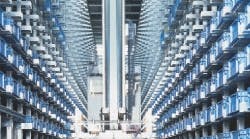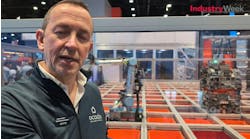Advances in power transmission have improved the performance, reliability and efficiency of conveying machinery, automated storage and retrieval, tray and pallet handling systems, loading and unloading, and other critical operations.
Many of these advances were inspired by constraints. For example, the transition to automated storage and retrieval systems (AS/RS) has been prevalent in urban areas where property values are at a premium and in high volume industries. Automated storage allows warehouse owners to better utilize vertical space than traditional manual racking systems in warehouse operations.
A number of major food products wholesalers and manufacturers operating on tight margins have made heavy investments in AS/RS technology to pull pallets of material from heights of 60-90 feet or more—and do it safely, quickly and cost effectively.
A recent application at a major foods wholesaler distribution center offers a good illustration.
Performance behind the Promise
The AS/RS in question was designed to cost effectively transform what arrives from each food or beverage company as a pallet full of a single product to a pallet with all the many different products necessary to re-stock a specific aisle or area of their customer’s grocery store. This is a very competitive industry with tight margins. It is also a consumer goods industry with an expectation of zero damage to products or their packaging. Products are dated and spoilage is a major concern. Perhaps most difficult of all is the need to track individual products throughout the process for recall or other purposes.
Full pallets are stored until product is needed. They are moved by conveyor to large AS/RS cranes which move the pallets down narrow aisles, lift them to open slots in the racking, and slide them safely into place. When product is needed from one of these pallets, the crane retrieves the pallet and places it on a conveyor to be moved to an area for de-palletizing.
The automated system breaks down each pallet into cases, which are placed on trays for transport via smaller roller conveyors. Most of the trays go back into storage until needed. They are routed by conveyor to smaller cranes operating in tray-width aisles and moved to dynamic storage locations. The trays which were immediately needed are routed by conveyor to a palletizer.
Products are removed from the trays and stacked onto a pallet of goods destined for a specific aisle in the grocery store. The system must take all the different products and create a stable pallet full of goods, with most pallets stacked six to seven feet tall and then automatically wrapped to further stabilize the goods for transport. These pallets are then loaded onto trucks for transport. Everything is timed to have the pallets completed minutes prior to the scheduled truck’s arrival at the dock.
From planning to implementation, the automation of this facility took two years. The project represented a significant investment with impressive returns. Actual ROI was less than one year, compared to a four year payback on labor-only. In addition to economic benefits, the automated system reduced food spoilage while vastly improving order fulfillment accuracy and speed.
Powering the Automation
In continuous or intermittent operations involving lifting or lowering, moving or positioning, seamless internal material flow is critical for many production processes. Geared motors with and without frequency inverters are used to drive conveyors of all different types. Frequency inverters add flexibility by providing soft starting and stopping in addition to being able to adjust running speed or position product without turning the motor on and off with a traditional contactor. This eliminates wear and resulting maintenance.
Storage and retrieval units are generally rail-guided, single track vehicles which distribute and remove goods in high-bay warehouses, requiring a more complex geared motor in conjunction with servo motors. Intelligent controls enable monorail overhead conveyors to approach their destinations automatically. Tracks required by this flexible and floorless means of transport are mounted on ceilings or pillars.
Drive Modules: Less is More
Transmissions, motors and frequency or servo inverters can essentially be viewed as a small electro-mechanical system. Precisely designed, they fulfill requirements for speed, torque, motion sequence, dynamics and positioning accuracy.
Drive selection depends on numerous factors—the application, mass to be moved and the dynamic performance required. Elements used for the connection of the drives and mechanical components typically include shafts, spindles and toothed belts.
The trend in automation is toward maximum availability through modularization, an intelligent reduction in the number of assemblies, and elimination of proprietary hardware. New generation drive controls embody a less-is-more concept with fewer discreet components. Standardized drive modules can then be refined for performance and scaled down for even greater space savings. A standardized drive package can consist of a frequency inverter, 60 Hz motor, and a gearbox.
Standard three-phase geared motors are suitable for most positioning processes that last longer than approximately 0.5 seconds. Apart from precision positioning applications that require high dynamic servo performance, most warehouse and plant operations can be managed more economically.
Software’s Language and Energy Efficiency
Computing technology and software have helped make automation a more affordable proposition. Software brings flexibility to plant automation and simplifies the relationship between automation partners and engineers by providing a common language and platform. Software can also drive a more agile and rapid response to customer demands.
One of those demands is for greater energy efficiency. Automation consumes more power. Virtually every aspect of the production processes, material transport and the plant infrastructure is reliant on electric motors. And within an automated central warehouse, about one half of overall energy cost represents material handling, storage and picking technology, with the balance comprised of heating, cooling and lighting.
Since electric motors and mechanical power transmission account for such a high proportion of overall energy consumption in industrial supply chain applications, they are the most effective means of increasing efficient energy.
Selecting the Right Drives
There are three significant energy and cost saving points to consider when specifying drive solutions for material handling applications:
1. Using electrical energy intelligently;
2. Converting electrical to mechanical energy efficiently;
3. Using energy recovered during braking.
There are also warehouse design strategies for reducing energy consumption. The most important places to start are by optimizing warehouse processes, utilizing ABC aisle layouts, adjusting the motor drive strategy for partial loads, and reducing the number and duty cycle of drives used.
From a drive design perspective, the goal is to use power wisely by combining energy efficient electromechanical gearing and drives optimized for the application. In practice, the load-dependent power needs are often used as the deciding factor in choosing the dimensions of drive solutions. To convert energy into motion most efficiently, one should scrutinize the entire drive train of an application. That also requires closely scrutinizing the overall warehouse management and interaction between control systems, drive technology and machine elements.
By using software design tools to guide selection of efficient components, energy consumption can be reduced by 20% or more. While energy efficient motors are well recognized for saving energy, high efficiency gearboxes may yield even greater returns. For instance, helical bevel gearboxes typically operate above 96% efficiency while traditional worm gearboxes are closer to 60% efficient.
Plant and distribution center engineers have industry proven tools at their disposal to aid in the design of automation motor drive systems. drive solution designer (DSD) software, for example, can rapidly perform in-depth analysis to easily size and choose optimal solutions. DSD calculates customized applications, selects the ideal components, and illustrates the energy usage of the solutions in the form of an energy certificate.
DSD can also compare several drive solution scenarios for a single application. Energy demands and usage can be calculated for a single machine, a complete production line, or the percentage of overall production costs, in addition to the CO2 emissions.
Many global challenges affect supply chain performance and efficiency. It is estimated that freight traffic will increase over 60% by 2030. Greater demands are already being placed on distribution centers competing to meet the needs of brick and mortar suppliers and stores, catalog sales and burgeoning e-business. Meeting these demands competitively requires automation solutions that perform with optimal reliability and efficiency.
Only when all elements of an automation solution are aligned can a custom-designed system architecture be implemented efficiently. Powerful engineering tools combined with the know-how of experienced motor drive applications engineers and optimized system design are all important factors for successfully automating a process or plant.
Chad McGraw is commercial product manager for Lenze Americas, specialists in drive and automation technology.



